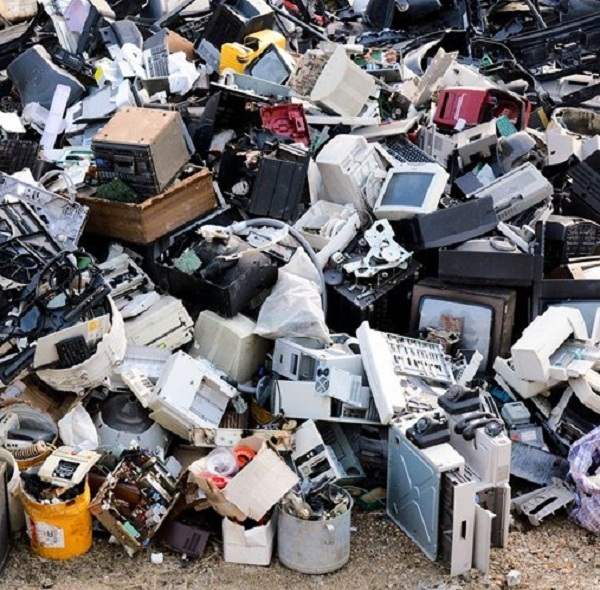If you want gold, look in a pile of discarded PCBs. If only it were easier to extract the value.
The United Nations Global E-Waste Monitor estimated that consumers, governments and companies threw away some 53.6 million tonnes of unwanted electronics in 2019. That represented an increase of 21 per cent over the amount discarded five years earlier. By 2030, the world could easily be dumping 74 million tonnes of e-waste “fuelled mainly by higher consumption rates of electric and electronic equipment, short life cycles and few options for repair”. Out of 2019’s haul, only 17.4 per cent of the waste was collected and recycled in some way.
It is a situation that has been building up for a while, John Shegerian, chairman and CEO of electronics-recycling specialist ERI, noted at the 2021 World Circular Economy Forum (WCEF). “E-waste is the fastest-growing solid waste stream in the world, but when I got into this industry 19 years ago it was the fastest-growing solid waste stream in the world then,” he remarked. “This is maybe one of the most imperative issues that we need to solve together.”
The motivation for doing something about the pile of e-waste is more than being responsible about cleaning up the mess. There is money in all that e-waste. The equipment might be mostly plastic and processed sand but buried in every chip are commercially viable quantities of gold, silver and other rare metals. The Global E-Waste Monitor published by a partnership between the International Telecommunications Union and the United Nations estimates that the value of recoverable metals in the 80 per cent of electronics that did not get recycled in 2019 could total $57bn. The gold and silver are used in minute quantities individually, mostly to coat connectors and form the tiny bond wires that connect silicon chips that do not use the more advanced flip-chip bonds to the pins of their epoxy package. But even in those trace amounts, the quantity of gold and silver in a tonne of printed-circuit boards (PCBs) with the components still attached is a little higher than you would expect to find in high-grade ore from a precious-metals mine.

In experiments on discarded mobile phones conducted in 2015 in which they dissolved the extracted PCBs in acid and recovered the noble metals, a pair of researchers at Delhi Technological University found up to 0.2g of gold in a kilogram of PCBs. Silver was, as with the ore from a typical mine, more abundant: a kilogram of phone PCBs yielded as much as 8g. By comparison, a kilogram of silver-mine ore generally contains around 2g of the metal. The World Economic Forum argued in a 2019 report that mining discarded electronics for gold results in 80 per cent lower emissions compared with mining and refining virgin metals.
The bad news is the cost of extraction: you need to manually separate components, grind up the boards and finally burn the plastic waste to eradicate poisonous organic chemicals such as polychlorinated biphenyls, which results in more carbon emissions and needs aggressive filtering on the exhaust to avoid contaminating the surrounding environment. And extracting the precious metals largely calls for the same cyanide-based leaching agents that the mine operators would prefer to phase out. Not only are they notoriously toxic, they are expensive to dispose of or recycle.
Part of the problem is that gold miners are now faced with much the same problem as urban miners. Many mines in operation today work on ores that contain both gold and copper. The bad news for them is gold’s comparative lack of reactivity means copper reacts far more readily with the cyanide, consuming most of the cyanide solution. A mine can easily spend more than $1,000 on the chemicals alone to recover a kilogram of gold, worth around $50,000, from more than hundreds of tonnes of high-quality ore.
In 2016, Stephen Foley, associate professor of chemistry at the University of Saskatchewan, and students Loghman Moradi and Hiwa Salimi demonstrated and patented a much cheaper and far less hazardous method for pulling gold and other noble metals out of pulverised boards based on a far weaker acid and an organic solvent that itself can be reused. Only around 100 litres at a cost of $50 for the chemicals are needed to extract a kilogram of gold, they claimed.
A year later, the trio formed a start-up and then raised $1m in 2018 on the Canadian version of ‘Dragon’s Den’ to get their Excir Works business off the ground – though the demonstration initially confused the judges because the gold coating on top of some of the devices on the board simply dissolved, before later being precipitated out.
In October last year, Excir signed a licensing deal with the UK’s Royal Mint to recover the gold from discarded PCBs at a plant being built at its secure site in South Wales. The Royal Mint expects to process around 90 tonnes of PCBs per week, which should net several hundred kilograms of gold per year.
Another option, though more experimental, is to use biology to extract and aggregate the metal. Some extremophile bacteria themselves depend on cyanide chemistry to survive, and teams have reported some success with different species of these bugs. In one experiment, the method proved more successful for copper than for gold, with almost all the bronze metal being recovered from the ground-up PCBs, though only about half the available gold.
Other rare and valuable elements in the chips remain difficult and expensive to recover, though techniques such as Excir’s that are less damaging to the materials than traditional methods may make it more viable for companies to look at recycling indium, hafnium and other rare earths that are used extensively within the industry.
To try to keep the ability to scale transistors further in density, the chipmakers are turning to an expanding list of elements. They will need ruthenium to reduce resistance in the copper traces placed on each chip to connect transistors together as well as gallium and arsenic to eke out more performance from the transistor, displacing the far more common silicon. The major problem is that they are used at very low levels within each device and are gradually displacing the precious metals like gold and silver, which will make the economics of recycling harder.
As the Approved Authorised Treatment Facilities Forum trade group pointed out to the Commons committee that looked at the potential for a circular economy for electronics in late 2020, the critical raw materials going into these chips are not necessarily expensive enough, unlike gold, to justify recovery commercially without additional incentives.
These incentives might appear in the future. The Royal Society of Chemistry has reported that supplies of some of these elements, including arsenic, gallium and indium, could easily run out if not recycled far more heavily. And more recently, given the role of China in supplying most of the world’s indium and other rare earths, geopolitics now plays a much bigger role.
Even though there has been plenty of work on alternatives that rely on far more common elements, indium remains a key constituent of transparent conductors in flat-panel displays. Recognising the element’s scarcity, suppliers such as the eponymous Indium Corporation already run recycling campaigns. But they are mainly for industrial waste, not the end products. As much as 70 per cent of the indium fed into sputtering chambers winds up stuck to the chamber surfaces themselves rather than the target LCD and then has to be cleaned off.
Recycling from the factory is also more popular for commonly available metals such as copper. Recycling specialists such as Belgium-based Aurubis focus on the waste that originates from semiconductor fabs and factories in the form of residues and dust. Recovering the metals from these waste streams requires less processing than trying to break down fully assembled electronics.
Attention is beginning to shift towards the rare but not so precious elements locked up in manufactured goods. The Taiwanese research institute ITRI picked up an award in 2020 from the European Association of Research and Technology Organisations for its work on a system to recover indium and other metals from flat-panel displays.
Though electronics recycling is becoming more of a focus as manufacturers scavenge for rare materials, a lot of the carbon-dioxide output is built into the product at source. At the Design Automation Conference late last year, ITRenew’s vice president of sustainability, Fahmida Bangert, claimed: “We’ve done extensive lifecycle cost analysis, which shows that the majority of the carbon footprint in the IT world is really in manufacturing, in the embedded emissions, as high as 75 per cent of it.”
Groups such as the WCEF back the approach of trying to eke out the effective lifetime of electronics by moving them to new applications once the original owner has discarded them. Acquired by Iron Mountain earlier this year, ITRenew has focused its own circular-economy business on data-centre and cloud-computing operators. Bangert says the company “is in the business of decommissioning IT hardware for all the global hyperscalers”.

The hyperscalers – providers of cloud and internet services who need to quickly scale to meet demand – represent an important target because they typically retire server hardware not long after buying them: choosing to replace them with faster, newer models as they become available because clients often want to use the cloud machines for short bursts of intense activity. The measurement of carbon emissions, however, acts as a strong encouragement to seek new users for their not-so-old but unwanted hardware. “If you look at, for example, Facebook’s 2018 carbon footprint, the operational carbon footprint becomes much smaller because [they] have invested pretty heavily in renewables, and that shifts the burden onto the manufacturing side,” Bangert notes.
ITRenew takes the full racks of equipment or server blades from hyperscalers and reconfigures into forms that are suitable for resale to companies that want in-house IT hardware. “We harvest the reusable parts and recycle the rest responsibly,” Bangert says.
In turn, by delaying the point at which the hardware finally goes into the disposal and, hopefully, recycling chain, the high up-front emissions can be amortised over a longer period when it comes to the final analysis. Though devices such as mobile phones and personal computers have become regarded as highly disposable, this trend may be reversing. A survey by trade-in specialist Hyla Mobile conducted in the US last year found the length of time before the average consumer upgrades to a new device is beginning to lengthen. The average age of Android phones and iPhones at trade-in increased to 3.32 years, up from the 3.15 the previous quarter. Trade-in prices also increased, reflecting a slowdown in the pace of development in that market and less incentive among consumers to upgrade.
Repurposing these devices is a trickier proposition, even though the Raspberry Pi modules have demonstrated how silicon designed primarily for mobile phones can fit many applications. Manufacturers have few incentives at the moment to allow end-of-life devices to be stripped from their cases and reprogrammed for other uses. Concerns over security have pushed them in the other direction.
Ravi Subramanian, senior vice president of IC verification and validation at Siemens EDA, says the focus in product engineering right now is more on materials and on recycling “rather than the reuse of the compute”. One issue that may call for a change in design objectives and incentives is how to square the need to obtain higher performance during a time where the traditional benefits of Moore’s Law scaling have largely gone away and where the systems companies have come back to designing their own highly customised chips.
“There are two worlds here. There’s a world of standard products and then there’s a world of application-specific products,” Subramanian says, pointing to the wave concept developed by former Sony executive Tsugio Makimoto in which chipmakers shift between generalised and highly customised products over time as the competitive landscape changes. “If you look at many industries, they may start with general-purpose products, then move to application-specific and then back to general-purpose.”
In the mobile-phone sector, it has gone the other way in recent years, Subramanian points out. “In the early days of mobile digital cellular – the days of GSM – Nokia and Ericsson were manufacturing their own chips. Then we started getting general-purpose chips provided by Texas Instruments and Qualcomm that became used in devices that the systems companies were developing. And the systems companies got out of designing application-specific devices. Then we saw the pendulum swing back for the next generation. For example, today in 5G, Nokia is building many of their own chips using their very large ASIC team in Europe.”
The problem is that though these designs are software intensive, they contain hardware modules that are specifically tuned to certain algorithms that will not be as useful outside 5G communications. A similar effect is taking hold in data-centre silicon, where accelerators are being used more extensively in place of general-purpose processors to handle machine-learning and other big-data applications.
This could limit the usefulness of server blades repurposed for other applications when they leave the cloud. Reuse advocates anticipate the growth in the use of artificial intelligence (AI) in the wider market may help stave off the problem. However, some items of hardware are highly specific to AI algorithms and may prove difficult to use even in seemingly related applications.
“It’s almost a decadal swing,” says Subramanian. “Because of the heterogeneity of the workloads in different industries, we are seeing a real push to more application-specific work, and the key drivers of that are price, area and performance.”
The question that design engineers are beginning to face is how to design for recycling as well as for carbon and recognise that the two may point in different directions, particularly if legislation intended to promote both is not well balanced. The hyperscalers have, not unreasonably, focused on operational energy as a major requirement for high-performance computers. That promotes the use of highly specialised accelerators that could prove tough to reuse elsewhere. Yet they are also investing heavily in renewable electricity generation for their data centres, which places far more emphasis on the embodied environmental damage.
They could find they spend less on carbon credits by shifting the balance back to consuming more energy in operations compared to manufacturing and disposal where they have less control over the use of renewables.
Subramanian points to the acquisitions of the main suppliers of field-programmable gate-array (FPGA) devices by processor makers, as well as the increasing use of embedded FPGA cores in the system-on-chip (SoC) engines being designed by the systems companies as one trend that may help a shift back to more general-purpose hardware.
“It is not the most power- and performance-optimised solution, but it is the solution that gives you the most flexibility to repurpose the logic that is dedicated for acceleration,” Subramanian says. Programmable hardware could prove to be the more sustainable option for servers. But portable devices, where battery life is everything, will likely demand custom accelerators that are hard to repurpose.
When electronics need to finally head for the dump, another question is how much the products can be designed for recycling. Some work is looking at biodegradable substrates and bonding methods that avoid the need to perform as much mechanical shredding, which produces clouds of dust. There are mechanical changes that systems manufacturers are beginning to make. However, products that come apart more easily could prove far less reliable in the field when they are meant to be operational.
The biggest practical change might not be so much in the delivery of products that come apart with little effort but information that describes how or what should be recovered. One possibility the UK government has proposed is more effective labelling combined with a central materials database that would record what goes into these products, but this particular project is currently on hold. Given the amount of electronics already out in the market that is not well labelled at all, it would take years for such a database to become useful for a significant proportion of the recyclable material. Until then, sifting through the world’s e-waste will be a treasure hunt on a grand scale.
Source: E&T










